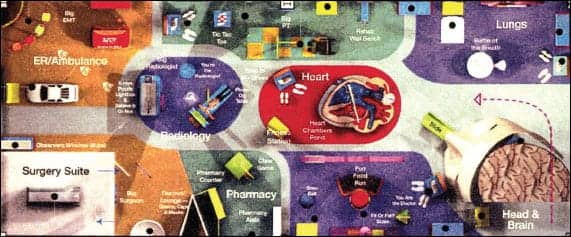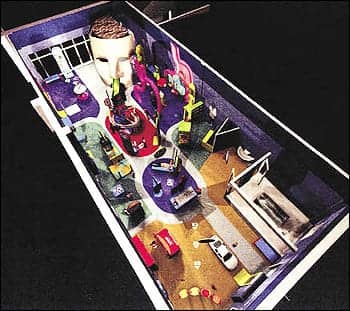Duncan regional hospital offers children a unique educational experience.
 |
| Cherilyn G. Murer, JD, CRA, is CEO and founder of the Murer Group, a legal-based health care management consulting firm in Joliet, IIl, specializing in strategic analysis and business development. Murer may be reached at (815) 727-3355 or viewed on her Web site: www.murer.com. |
Keeping today’s children healthy is one of the most effective ways to control American health care costs. Teaching children to get healthy, live healthy, and remain healthy is one of the best life lessons learned. Health education is the most direct way to improve quality of life from childhood to adulthood. Hospitals and foundations throughout the country have committed to helping solve key health care issues by putting personal health back into the hands of the patient via educational programs.
DUNCAN HANDS ON HEALTH OVERVIEW
One hospital that has taken the commitment to youth health care education to another level is Duncan Regional Hospital in Duncan, Okla. In September 2008, the hospital opened the “Hands on Health Interactive Child Learning Center” on its campus. The project is the first of its kind in the United States, integrating state-of-the-art multimedia, adolescent health education and prevention, and clinical interaction with the superior staff of Duncan Regional Hospital. This dynamic program is an experimental and educational program for children from preschool through eighth grade with a goal of allowing them to explore, interact, and discover key health-related lessons that will shape their lives and their careers.
Hands on Health is touted as the only place in the nation for young people to achieve this goal. It is also the place for students to begin a positive, lifelong understanding of the importance of good health. It helps equip young people with awareness that personal health is their responsibility and simultaneously ignites passion to pursue health care careers.
Hands on Health has proprietary technology that, with the touch of a button, can transform the entire interactive center into a learning experience that is age appropriate. All of the videos, animation, and games change depending on the grade level of the children visiting. The creators of Hands on Health, including local educators, developed curricula that are directly linked to Oklahoma PASS standards.
 |
| The floor plan illustrates the entire museum. Each learning area encompasses ample space for small groups of five or six to gather, and for traffic flow between exhibit spaces. |
Hands on Health features a wide variety of exhibits, including a virtual operating room where children don a mask and gown, wash their hands under a special “germ detector,” and then proceed into the operating room where they are guided through a surgery by an interactive video presentation. Other exhibits include a video game race where eating choices will determine how the player will perform in the race, a comparison between a healthy set of lungs and those of a smoker, and what it feels like to ride on a sneeze while sliding out of an oversize nose. “This is a place for students to experience something entirely new,” says Beth Curry, program coordinator. “Students will truly have their ‘hands on health.’ “
FOCUS ON IMPROVING HEALTH
The Hands on Health Learning Center is committed to helping combat childhood obesity and other common ailments that afflict Americans. Several educational areas have “fitness stations” dedicated to demonstrating to young children the importance of exercise.
Additionally, as students enter the stomach educational area, they can compete in an electronic cross-country competition, the “Fun Food Run.” By selecting nutritious foods, the child’s runner proceeds at a swift pace toward the next refueling station and eventually the finish line. If they are given unhealthy snack foods, the runner struggles to keep up without the right foods that the body needs to produce enduring energy.
In addition to obesity, another focus area of Hands on Health is the cigarette station in the lung area. This exhibit involves an oversized cigarette labeled “Danger! Lung Poison” and is decaled with all of the toxic ingredients in cigarettes. Students can pull magnetized black lung particles from the tip of the cigarette through the mouth, over the tongue, and into a lung, where they fill up and cover a pink lung, illustrating the effects of smoking and air pollution.
 |
| A bird’s-eye view of the Center. |
CAREER EXPOSURE
The 2,400-square-foot facility has several different learning areas, including emergency, surgery, sports therapy, pharmacy, and radiology. Not only does Hands on Health promote education about health and wellness for children, it also exposes children to a variety of health care careers. Scott Street, president and CEO of Duncan Regional Hospital, says, “Hands on Health puts health and health careers into the minds of our children. We have a national shortage of health care professionals, and we want to help change that.”
In the Hands on Health Learning Center, children will encounter 8-foot medical professionals associated with various hospital exhibits. Each professional is supported with the names of other medical professionals in their area to introduce students to the many exciting health care careers. In many learning areas, a “Step-In-My-Shoes Station” (SIMSS) is featured, which enables a child to experience a day in the life of medical professionals who work in the certain medical areas.
For example, in the head learning area, there is a SIMSS just outside of the ear that enables the child to experience a day in the life of a neurologist and an ear/nose/throat specialist. One medical professional is featured on the front side of the station and the second is on the back side. All SIMSS stations are designed as a destination to be approached and stopped at. The children plant their feet in either metal shoes or graphic shoes that a wheelchair can roll over. Pressure plates under the shoes activate the video player and monitor built into the station and centered between the physical shoes and graphic shoes so that two students at a time can experience SIMSS. Before a student “steps into” the shoes, a video sequence plays on the monitor, inviting engagement by the child.
REHABILITATION-FOCUSED EDUCATION
 |
The Duncan Hands on Health Learning Center introduces children to the world of rehabilitation careers and helps sensitize children to those with physical handicaps. While many young children already have exposure to the medical professions of physicians and nurses, exposure to other medical careers, like rehabilitation, is much less common. Additionally, many children are unaware of the difficulties those with physical handicaps face in daily life and Hands on Health acclimates young children to these issues.
The Rehabilitation/Sports Medicine Exhibit of Hands on Health features rehabilitation careers and empathy-learning. Students experience what it is like to use a wheelchair at the Wheelchair Station as they attempt to navigate uneven, sloped surfaces and pass through a doorway. Curry states, “It is truly amazing how students walk away with a sense of accomplishment and understanding after taking part in something as meaningful as having to maneuver a wheelchair over various surfaces and obstacles.” Another portion of the exhibit is dedicated to mobility and accessibility issues by having children put their arm in a special cast that is fixed in place on a custom-constructed game table with the ability to slide forward and backward. Here the students attempt to play Arm-Cast tic-tac-toe on a whiteboard using a tethered marker and eraser.
Additionally, at the Rehab/Sports Therapy Station, visitors use decaled exercise figures on a mirror to copy various therapeutic moves. Energy is put to the test as the children work legs and arms using resistance bands by following the graphic examples that illustrate concepts of muscle tone, development, and recovery. Other students can flex their muscles as they flex an anatomically correct knee and discover a hidden knee tear.
Key concepts addressed at the rehab/sports station include the following:
- How easy is it to move over different surfaces in a wheelchair?
- Can you open doors and reach things that are higher than you in a wheelchair?
- How good is your tic-tac-toe game in a cast?
- What happens to muscles, tendons, and ligaments if you do not exercise?
- Should you use ice or heat to treat sports injuries?
- Just what is the knee bone connected to?
A DAY IN THE LIFE
The Rehab/Sports Therapy SIMS Station walks children through the day of medical professionals working in rehabilitation and sports therapy. Exposure to the wide variety of rehabilitation-related careers is critical because it helps pique the interest of young children related to the world of physical medicine and rehabilitation. The wide variety of careers featured at this station include orthopedic surgeon, sports/rehab therapist, sports injury therapist, occupational therapist, physical therapist, therapist assistant, rehabilitation nurse, recreational therapist, kinesiotherapist, exercise physiologist, and rehabilitation therapist.
CONCLUSION
Before Duncan Hands on Health opened in September 2008, it was merely a twinkle in the eye of Duncan Regional Hospital’s CEO, Scott Street. He envisioned a fun place that would ignite passion among young people to pursue health care careers while simultaneously equipping them with an awareness that their personal health is their responsibility. Hands on Health accomplishes both of these goals, and Street’s mission has come to fruition. Duncan Regional Hospital’s dedication and commitment to providing critical health care education to the youth of America are evident through Hands on Health. Other health care providers and institutions throughout the country should strive to follow in Duncan Regional’s footsteps by helping the youth of America get their “Hands on Health.”
Cherilyn G. Murer, JD, CRA is CEO and founder of the Murer Group, a legal-based health care management consulting firm in Joliet, Ill, specializing in strategic analysis and business development. Murer may be reached at (815) 727-3355 or viewed on her Web site: www.murer.com.




